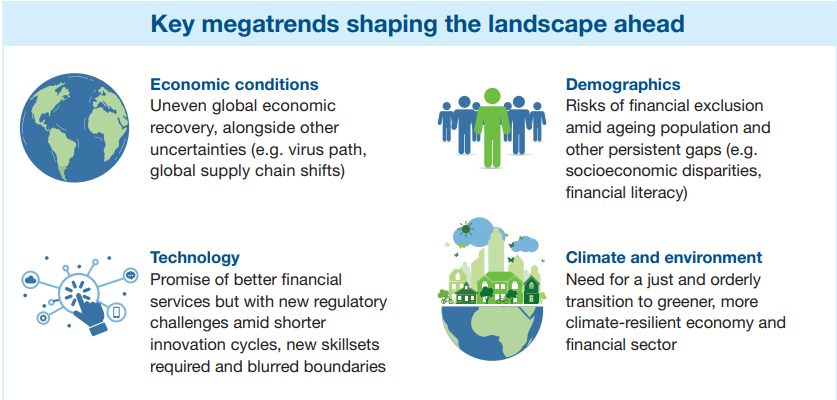
Malaysia focuses on fintech, sustainability with new financial blueprint
Malaysia launched its latest financial sector blueprint for 2022-2026 earlier this morning at MyFintechWeek 2022. Held virtually, the event themed “Advancing Digitalisation for Recovery, Sustainability, and Inclusion” was hosted by Malaysia’s central bank, Bank Negara Malaysia.
Implications of the blueprint are wide as it would be affecting both the financial and non-financial sectors, especially enterprises and businesses doing business in or with the country.
BNM identified four megatrends shaping the economic landscape:

The blueprint identified three broad themes influencing desired outcomes and targets for 2026 — finance for all, finance for transformation, and finance for sustainability.

Importantly, it proposes five strategic thrusts for 2022 – 2026. They include:
- Funding Malaysia’s economic transformation
- Elevating the financial well-being of households and businesses
- Advancing digitalization of the financial sector
- Positioning the financial system to facilitate the transition to a greener economy
- Advancing value-based finance through Islamic Finance leadership
“As we walk along the path of economic recovery, larger threats are knocking on our door. Climate change, biodiversity loss, and demographic change are no longer hypothetical threats; they are real and urgent” warned the Malaysian Minister of Finance, Tengku Zafrul Aziz.
“Make no mistake. These challenges should not be left to our children or grandchildren to solve. The solutions and the embracing of change begin today. And they begin with us, including the financial community.”
Zafrul Aziz shared that between 2011 and 2020, the adult population in Malaysia with deposit accounts increased from 82% to nearly 96%. Furthermore, domestic credit to the private sector as a percentage of GDP increased from 108% to 134%. E-payment transactions per capita increased from 49% to 170%.

The finance minister quipped that these increases were spurred by COVID-19 as well as technological advancements in the financial industry that have enabled consumers to “enjoy digital solutions throughout the financial value chain”.
As compared to pre-pandemic levels, in 2020, merchant registrations for QR acceptance increased 164%, whereas online banking transaction volumes increased 49%.
The finance minister added that the Malaysian government is committed to supporting local businesses through the Program Semarak Niaga Keluarga Malaysia (SemarakNiaga), worth 40 billion ringgit; strengthening public healthcare facilities in managing COVID-19; and continuing the sustainability agenda, including the issuance of ringgit-denominated Sustainability Sukuk later this year.
“Our digital inclusivity aspirations will remain unrealized without the appropriate infrastructure to support it. To that end, various measures under Budget 2022 will also pave the way for the rakyat and businesses to embrace digitalization, and this policy is set to continue in future Budgets”, he added.
Under Budget 2022, measures include:
- RM700 million ringgit allocation for our nationwide digital connectivity initiative, JENDELA;
- RM1 billion ringgit under Bank Negara Malaysia’s SME Automation and Digitalisation Facility
- RM150 million ringgit for digital content creation for the creative industry
- RM200 million ringgit under the MSME Digitalisation Grant
Additionally, the MyDIGITAL Corporation has also been tasked to implement Malaysia’s Digital Blueprint with an emphasis on public sector digitalization efforts and nurturing digital talent.
The minister urged the financial sector to continue the inclusivity agenda while supporting the nation’s aspirations.
“The strategies laid out in the Blueprint will be critical for the financial sector to navigate the oncoming challenges and opportunities – in turn, complementing the Twelfth Malaysia Plan”.
The key expected outcomes of the blueprint include:
- advancing digitalization of the financial sector;
- providing meaningful choice and access for consumers;
- increasing the vibrancy of the funding ecosystem to meet Malaysia’s economic needs;
- wider adoption of green finance and sustainability practices.
The minister also urges the financial sector to collaborate with the government. He anticipates the entry of digital banks, digital insurers, and takaful operators, sharing that their presence and impact through the use of tech and innovative financial solutions will “foster greater efficiency and contribute towards a more competitive financial landscape.”
Last year, Tech Wire Asia reported several movements in the financial and tech sector, viz a move to sustainability.
Malaysia’s financial blueprint strategy is in line with a number of other banks in the Asia Pacific that have prioritized climate change impact for risk management and adopted greener measures to reduce their carbon footprint.
READ MORE
- 3 Steps to Successfully Automate Copilot for Microsoft 365 Implementation
- Trustworthy AI – the Promise of Enterprise-Friendly Generative Machine Learning with Dell and NVIDIA
- Strategies for Democratizing GenAI
- The criticality of endpoint management in cybersecurity and operations
- Ethical AI: The renewed importance of safeguarding data and customer privacy in Generative AI applications
